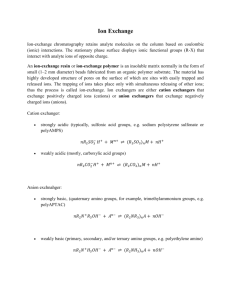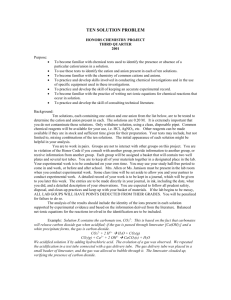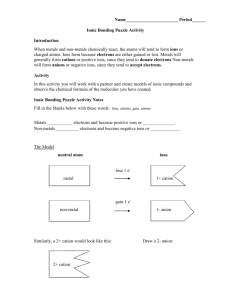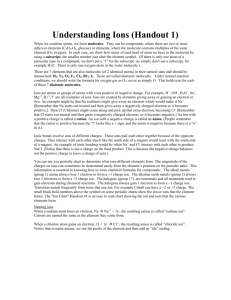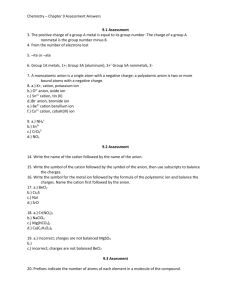PRL_Supplement_V5b
advertisement
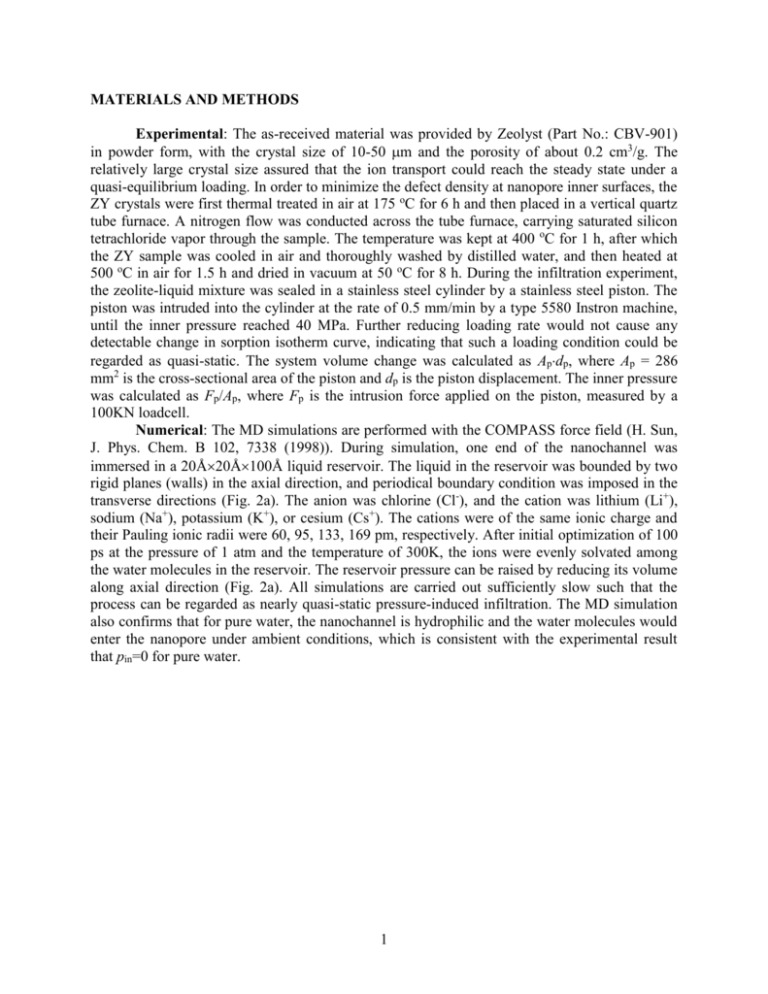
MATERIALS AND METHODS Experimental: The as-received material was provided by Zeolyst (Part No.: CBV-901) in powder form, with the crystal size of 10-50 m and the porosity of about 0.2 cm3/g. The relatively large crystal size assured that the ion transport could reach the steady state under a quasi-equilibrium loading. In order to minimize the defect density at nanopore inner surfaces, the ZY crystals were first thermal treated in air at 175 oC for 6 h and then placed in a vertical quartz tube furnace. A nitrogen flow was conducted across the tube furnace, carrying saturated silicon tetrachloride vapor through the sample. The temperature was kept at 400 oC for 1 h, after which the ZY sample was cooled in air and thoroughly washed by distilled water, and then heated at 500 oC in air for 1.5 h and dried in vacuum at 50 oC for 8 h. During the infiltration experiment, the zeolite-liquid mixture was sealed in a stainless steel cylinder by a stainless steel piston. The piston was intruded into the cylinder at the rate of 0.5 mm/min by a type 5580 Instron machine, until the inner pressure reached 40 MPa. Further reducing loading rate would not cause any detectable change in sorption isotherm curve, indicating that such a loading condition could be regarded as quasi-static. The system volume change was calculated as Apdp, where Ap = 286 mm2 is the cross-sectional area of the piston and dp is the piston displacement. The inner pressure was calculated as Fp/Ap, where Fp is the intrusion force applied on the piston, measured by a 100KN loadcell. Numerical: The MD simulations are performed with the COMPASS force field (H. Sun, J. Phys. Chem. B 102, 7338 (1998)). During simulation, one end of the nanochannel was immersed in a 20Å20Å100Å liquid reservoir. The liquid in the reservoir was bounded by two rigid planes (walls) in the axial direction, and periodical boundary condition was imposed in the transverse directions (Fig. 2a). The anion was chlorine (Cl-), and the cation was lithium (Li+), sodium (Na+), potassium (K+), or cesium (Cs+). The cations were of the same ionic charge and their Pauling ionic radii were 60, 95, 133, 169 pm, respectively. After initial optimization of 100 ps at the pressure of 1 atm and the temperature of 300K, the ions were evenly solvated among the water molecules in the reservoir. The reservoir pressure can be raised by reducing its volume along axial direction (Fig. 2a). All simulations are carried out sufficiently slow such that the process can be regarded as nearly quasi-static pressure-induced infiltration. The MD simulation also confirms that for pure water, the nanochannel is hydrophilic and the water molecules would enter the nanopore under ambient conditions, which is consistent with the experimental result that pin=0 for pure water. 1 SUPPLEMENTAL RESULTS In the three sections below, based on energy analyses and physics based models we respectively answer the following key questions: Why do the infiltrated ions form an ordered sequence shown in Fig.2 (i.e. a cation followed by a number of anion-cation couples)? How does the nanocrystalline-like ion couple form inside the molecular-sized channel where the effective solubility of ions is essentially zero? Why does the spacing between adjacent ion couples depend on the cation size? 1. Mechanism of the formation of the ordered sequence of infiltrated ions An independent energy analysis is performed to shed light on the ordered sequence of ions (Fig.2b-e) found in the MD simulation, which is a commonality among the three ion infiltration cases (LiCl, NaCl, and KCl). Starting from an empty nanotube, we compare the energy barriers of the infiltration of an anion and that of a cation. It is assumed that all ions are centrally located and moved along the axial direction. After an ion enters the tube, the process is repeated to identify the next preferred one. Eventually, a sequence of the ion distribution can be determined. Three key instants are examined, as shown in Fig.S1(a). Stage 1 refers to the instant when the first ion is infiltrated, where “1A” illustrates the possibility that a cation (positioned at the tube opening) would infiltrate the nanopore, and “1B” corresponds to the alternative situation that an anion would first enter the same nanotube. In either case, there is a counter-charge placed outside the tube to keep the system neutral. The position of the counter-charge is determined such that it could reproduce the same force acting on the infiltrated ions as that imposed by the electrolyte solution outside the nanopore in the MD simulation. The examined ion is then perturbed by several Å along the axial direction, and its interaction energy with the nanotube and the counter-charge is computed. The energy variations are plotted in Fig.S1(b), where an upwards curve implies energy consumption while the downward trend indicates an energetically favorable process. It is clear that from the energy point of view, it is preferred for a cation to first enter the nanopore prior to an anion, since in the examined nanochannel the influence of the oxygen atoms is more pronounced. The subsequent stage 2 assumes that a cation has already infiltrated, and we explore which ion (a cation or an anion) tends to infiltrate next. In this case, the counter-charge should be -2e for case “2A” and 0 for case “2B”. As plotted in Fig.S1(c), configuration “2A” decreases system energy and therefore another cation can enter the nanopore (primarily owing to the size of the small cation). Similarly, the analysis of stage 3 (Fig.S1d) indicates that an anion tends to follow the two previously infiltrated cations. The above analyses reveal that the sequence of the first three infiltrated ions should be cation → cation → anion, as illustrated in Fig.S2 (stages 1~3), which holds for all the three electrolytes under investigation: LiCl, NaCl, and KCl (Cs+ cannot infiltrate the nanochannel, which will be discussed in the next section). Note that, the opposite ions (e.g. the 2nd and 3rd ions) in the nanochannel tend to approach and pair with each other because of the Coulomb attraction – the formation mechanism of such ion couple is discussed in Sect.3 of the Supplement. After the infiltration of the first three ions (stage 4), there is only one net positive ion charge inside the channel and one counter-charge outside, leading to a situation similar to the end of stage 1 in Fig.S2. Thus, the subsequent infiltration of ions would repeat stages 2~4, as more and more cation-anion couples enter the nanochannel (stage 5). Once the ion couples are deep 2 inside the tube, due to the interaction with the leading cation, the anion and cation would prefer to switch their positions to reduce energy (stage 5). Finally, a quasi-periodical chain-like structure of infiltrated ions is formed (stage 6 in Fig.S2, the “steady-state”): almost all the infiltrated ions form couples, led by an anion closely followed by a cation, except that in the infiltration front there is a single cation, and at the end of the chain (at the tube opening) the ion couple just infiltrated is led by a cation followed by an anion. Due to the hydrophilic nature of the tube under investigation, a few water molecules may separate the infiltrated ion pairs. Such configuration predicted from energy analysis matches qualitatively with the sequence of the infiltrated ions in MD simulation (Fig.2). 2. Size dependent geometry of the quasi-periodical structure of infiltrated ions The analysis in Sect.1 shows that it is energetically favorable for cations and anions to enter the nanochannel with a regular pattern. However, such similarity of infiltration sequence (shared by LiCl, NaCl, and KCl) cannot explain the intriguing ion size effect on the ion transport pressure, pin, for which the details of the ion structure must be examined. Figure 2 shows that the averaged spacing between ion couples, b, is smaller for smaller cations, suggesting that the possibility of infiltration of a smaller cation is higher. The results in Fig.S1(b-d) are computed by moving respective ions along the axial direction, where there is not much difference among Li+, Na+, and K+. Recall that during the actual infiltration process in the MD simulation, the in-plane motion of ions is important due to the thermal vibration and the complex multi-body interactions. Thus, a refined energy analysis is performed. In Fig.S3, an in-plane energy analysis is carried out, where an energy contour plot is established by moving an cation or a water molecule in the cross section of the channel. For a water molecule, the orientations of H-O bonds are optimized during this process. For small ions such as Li+ and Na+ ions, a large plateau is found in the central part of the channel, within which the energy is only slightly varied – at any point inside this region, the ion has nearly the same probability of infiltration. By contrast, the energy plateau is small (i.e. the radial gradient of energy is quite high) for large cations such as Cs+, mainly due to their large vdW radii. Considering cations at the tube opening, a smaller one (e.g. Li+ or Na+) has a larger potential entry area within which the energy barrier is low, and thus statistically, the probability of infiltration is higher. This gives a smaller cation more advantage in its competition of infiltration with water molecules, leading to a higher frequency of ion infiltration and thereby a smaller b (compared with larger ions). When the cation is too large, such as for Cs+, the infiltration is energetically unfavorable, and this explains why only water molecules could enter the hydrophilic nanopore and ions are left outside in the CsCl solution. When the nanopore is neutral (e.g. a carbon nanotube, CNT), a similar energy analysis shows that the small cation is still preferred to infiltrate the nanotube, and followed by an anion. A similar periodical structure would still form in the sequence of cation-anion couples, although the overall infiltrated structure is typically neutral. 3. Mechanism of the formation of nanocrystalline-like ion couples The energy analyses above show that after the infiltration of a cation, either an anion (Cl-) or a water molecule may enter the tube with similar probabilities. It is possible that close to the tube opening, an infiltrated cation and an infiltrated anion are separated by a few water 3 molecules. However, upon steady-state, one of the interesting features of the infiltrated ion structure is the formation of nanocrystalline-like ion couples, which indicates that the solvation of ions is essentially impossible in a molecular-sized nanochannel. In other words, once well inside the nanotube, the infiltrated ions are no longer scattered; instead, a cation always approaches and pairs a nearby anion, until all water molecules initially bounded by the two ions, if any, are “pushed away” from the cation side, thus forming an ion couple. In order to understand this procedure from an energy perspective, two factors need to be taken into account. One is the variation of system free energy associated with the transition from a scattered ion structure (Fig.S4a) to a paired ion structure (ion couples, Fig.S4b), and the other is the energy barrier for water molecules to bypass the ions embracing them. Taking the infiltrated NaCl electrolyte as an illustrative example, we first estimate the energy variation induced by the structural change. The ion structure is assumed to have parameters approximately equal to those obtained from the MD simulation: in the nanocrystalline-like (paired) structure (Fig.S4b), the spacing between the two ions in a couple is a=2.4Å and the separation between adjacent ion couples is b=15Å, both consistent with Fig.2(c); in the scattered ion structure (Fig.S4a), we assume all ions are separated with an identical spacing of c=8.7Å. Due to the prominent electrostatic interactions among ions, the influence of water molecules is secondary. The potential energy of the two ion structures are evaluated as 751kCal/mol and -299kCal/mol, respectively, implying that the formation of ion couple is accompanied by a prominent energy reduction of about 75 kCal/mol, which is therefore energetically favorable. For the scattered state (Fig.S4a) to become the nanocrystalline-like structure (Fig.S4b), an energy barrier must be overcome: when the two oppositely charged ions approach each other, water molecules in between them, if any, must escape the encirclement by bypassing an ion (Fig.S4d). During this process, the energy barrier peaks when a water molecule and an ion are within the same cross-section (when they are about to switch their positions). By minimizing the potential energy with respect to the in-plane positions of a water molecule and an ion (Fig.S4e), the energy barrier is evaluated to be 5kCal/mol for a water molecule to bypass a Na+ and 64kCal/mol to bypass a Cl-. Apparently, the larger size of Cl- leads to a higher energy barrier and the water molecule prefers to switch position with the Na+. Comparing 75kCal/mol and 5kCal/mol, energetically, the energy reduction associated with structural reorganization is much larger than the energy barrier. Consequently, the oppositely charged ions would have a strong intention to approach each other, at the expense for bounded water molecules to switch their positions with a cation, such that the ion couple can be formed eventually. If the separation between the two ions is too large, such ion couple may be difficult to form. Such a pathway matches with ob[1]servations in the MD simulation very well. Given that the above structural change is irreversible, in order to keep the nanocrystalline-like structure (Fig.S4b) stable (such stability was observed in the MD simulation, Fig.2b-d), the formed ion couple configuration (Fig.S4b) should not further aggregate to a continuous ion strand (Fig.S4c). Another energy analysis is carried out, where the potential energy of the nanocrystalline-like (Fig.S4b) and the aggregated (Fig.S4c) structures are calculated as -751kCal/mol and -937kCal/mol, respectively. Theoretically, the structural reorganization from Fig.S4(b) to Fig.S4(c) would possess an energy reduction of 44kCal/mol. However, a prerequisite for the formation of such an aggregated structure (Fig.S4c) is that the bounded water molecules must be able to bypass the large Cl- ion, which has an energy barrier as high as 64kCal/mol, larger than the overall potential gain. Thus, aggregation of nanocrystalline- 4 like ion couples is not likely to occur. From energy point of view, a larger nanocrystalline-like structure would only form when two ion couples entered the nanopore one after another, such as a Na+ immediately followed by a Cl-, a Na+, and another Cl- without any water molecules in between them. This is theoretically possible but the probability is quite small, and was never observed in our MD simulation. All these energy analyses match the MD simulation quite well: once an anion and a cation are both inside the nanopore, they approach and pair each other while water molecules in between are “pushed away” from the cation side. Following this procedure, nanocrystalline like ion couples are formed for all the three infiltrated electrolytes (Fig.2b-d). The structure of ion couples thus formed is quite stable. Energetically, the formation of ion couples is irreversible. Similar formation mechanism of ion couples also holds in a neutral molecular-sized nanochannel (e.g. a carbon nanotube). It should be noted that in order for the ion-couples mechanism to become prominent, two preconditions are required: (i) The nanochannel size must be molecular sized; i.e. at the level of a few Å. Only under this condition can the hydration of ions be severely distorted, making two oppositely charged ions more inclined to aggregate and form a nanocrystalline-like structure. (ii) The study should focus on the transient process of ion transport from a bulk reservoir into the nanochannel. The dynamic transition from bulk state to confined state can greatly assist the formation of ion couples, as established equilibrium (fully developed hydration shells) is destructed and ions are seeking for new equilibrium inside the channel. 5 FIGURE CAPTIONS Figure S1. Energy analysis of the axial motion of individual ions: (a) the six cases examined, each corresponding to a possible ion infiltration sequence at a representative instant during the infiltration process; in each case, the ion at the tube opening is perturbed by 1.5Å ~3Å along the tube axis; (b)-(d) the interaction energy between the moving ion and the system, where the possibility “A” is more energetically favorable at all instants. Figure S2. Step-by-step schematic of the sequential infiltration and configuration of ions inside the nanochannel (water molecules are not shown). Figure S3. Energy analysis of the in-plane motion of individual ions and water molecule: the ion/molecule is placed at various positions around the tube center to measure the variation of its interaction energy with the nanopore. The energy value at the tube center is adopted as the ground state. The diameter of the black circle equals to 4.5Å. Figure S4. Energy analysis of the formation of nano-crystal-like ion couples: (a) postulated scattered ion structure; (b) paired ion structure (the nano-crystalline-like ion couples observed in MD simulations, Fig.2); (c) a postulated continuous ion strand; (d) an cation approaches a nearby anion by pushing away water molecules in between; (e) the instant when a cation bypasses a water molecule. 6 Figure S1 Stage 2 Stage 3 Energy variation, E (kCal/mol) Stage 1 1A, Li 1A, Na 1A, K 1B 100 75 50 25 0 -25 -50 (b) -1 (a) 0 1 2 3 Axial position along the nanopore (Angstrom) 2A, Li 2A, Na 2A, K 2B 50 Energy variation, E (kCal/mol) Energy variation, E (kCal/mol) 75 25 0 -25 (c) -1 0 1 2 3A 3B, Li 3B, Na 3B, K 100 75 50 25 0 -25 -50 (d) -1 3 0 1 2 Axial position along the nanopore (Angstrom) Axial position along the nanopore (Angstrom) 7 3 Figure S2 b a Stage 1 2 3 4 8 5 6 Figure S3 Frame 001 10 Sep 2008 Internally created data set Frame 001 10 Sep 2008 Internally created data set Frame 001 10 Sep 2008 Internally created data set 100 20 10 5 400 100 20 5 20 5 0.2 0.2 0.2 5 5 10 20 (a) Li+ 20 5 20 100 100 400 (b) Na+ (c) K+ Frame 001 10 Sep 2008 Internally created data set Frame 001 10 Sep 2008 Internally created data set 400 10000 100 20 1000 5 20 0.2 5 0.2 20 5 1000 20 100 10000 400 (d) Cs+ (f) H2O 9 Figure S4 a=b=8.7Å b (a) a a=2.4Å; b=15Å (b) a=b=2.4Å Cl Na (d) [1] (c) Y. Qiao, L. Liu, and X. Chen, Nano Letters, in press (2009). 10 (e)


